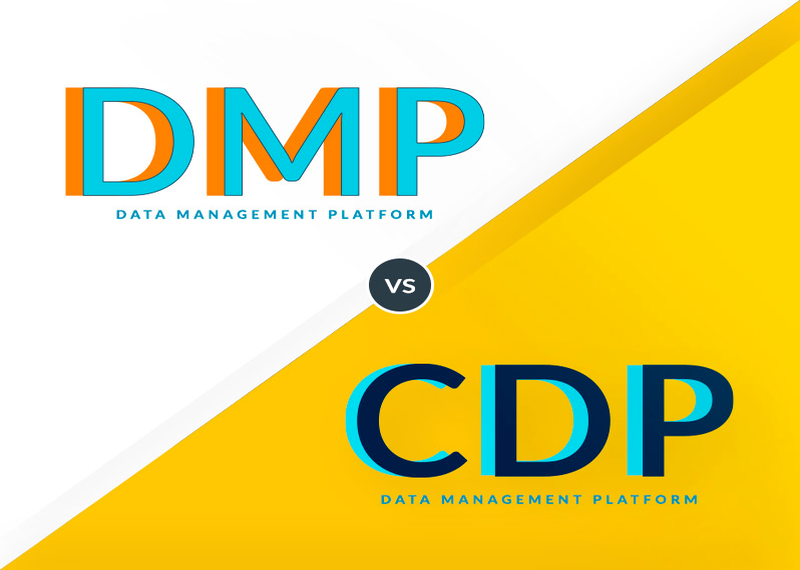DMP/CDP what is the difference?

Data-driven insights, data management and data-driven marketing strategies are popular buzzwords, but the primary force behind all of them is improving the customer experience. With so many options available to the modern consumer, countless organisations are battling over who can create the most meaningful, engaging experiences and how to use data to create them.
In the age of customer experience, access to and ownership of customer data is key for brands looking to build audience relationships and measure the impact of their efforts. Technologies such as Customer Data Platforms (CDPs) and Data Management Platforms (DMPs) can help organisations make sense of the data they collect and shape their strategy accordingly.
Let's look at the key differences between DMP and CDP.
What is the difference between CDP and DMP?
Although each platform collects and applies data to marketing initiatives, they are not interchangeable and deserve unique analysis. CDPs and DMPs each perform different functions in terms of data focus and functionality. But first some definitions:
Customer Data Platform (CDP): aggregates and combines data from channels and systems to create a single source of truth for all customer data. It brings together zero, first and third party data to create comprehensive customer profiles and update them in real time.
Data Management Platform (DMP): Collects third-party data sources — cookie IDs, IP addresses visited, and other anonymous data points — for segmentation to more effectively target those customer segments with paid advertising campaigns across diverse platforms.
The differences may not seem like much, but depending on the organisation's intent and needs, both platforms offer unique aspects of data management. By zooming in a little more, it is easier to identify the more nuanced differences.
Customer Data Platform (CDP)
CDPs work primarily with first-party data or data collected by the company directly from users, which by its nature offers greater control over how data is used, tagged and strategically designed. CDPs have three main functions:
- Unified Customer View: integrating, cleansing, standardizing, deduplicating and placing customer data in a single source across online and offline channels to get a complete view of the customer.
- Customer analytics and machine learning: The scale and granularity of atomic-level data is important, but marketers need smart data. Predictive analytics can help identify data patterns and reduce complexity and noise, amplifying marketing intelligence.
- Connectivity to customer interaction systems: CDPs, whether batched or via real-time APIs, serve as an intelligent backbone for customer data to ensure that a customer's web browsing event - or a store return or call centre complaint - is available in the system to impact changes in communication and customer experience.
The essence of CDP is that data can be stored and accessed at different levels of detail. How you choose to do this is not limited by the technology itself.
Data Management Platform (DMP)
DMPs focus primarily on third-party data, anonymous data sold by data collection companies. Data offers less control because it arrives as it is. Nevertheless, third-party data is extremely useful for targeting potential customers.
For example, if you have purchased third-party browsing data from a data collection company and have seen that certain browsing interests of users are similar to your product, you can use this information to serve targeted ads to where they are browsing. It can certainly be argued that DMPs are partly responsible for some consumers believing that ads read their minds.
Ads cannot read minds, but DMPs can use freely provided data to determine interests based on past web behaviour. That box is the one you ticked but didn't bother to read and was about third-party cookies. You have agreed to upload your data machine and give millions of companies the opportunity to bid for your wallet based on the information you provide. Some DMP highlights:
- Access to huge data sets: data collection companies are notorious for capturing all kinds of user data. They are anonymous data, but still valuable if properly exploited for targeted advertising campaigns.
- Gathering new layers of audiences: third-party data is a great way to reach potential customers who may not have known they were interested in your product - yet. By segmenting profiles, your organisation can advertise widely from one platform across different advertising platforms based on pre-defined metrics.
- Combine what you know with what you don't: Compare the user data you already have with anonymised, third-party data. Use this data comparison to create matches based on web usage characteristics that align common customer characteristics with prospects. Then target ads and tailor content accordingly.
DMP allows an organisation to use anonymous data to cast a wider net and reach potential customers who might otherwise have been ignored, or who simply didn't know it existed.
CDP vs DMP: Which is right for your organisation?
There is no data management skeleton key, and every organization should prioritize its needs before deciding whether to choose CDP or DMP. Let's review what we know about them at the highest level:
- CDPs use first-party data to capture the individual customer view, resulting in a data portrait that is fully tailored to each user and used to create highly personalized digital experiences.
- DMPs use third-party data to match anonymised web behaviour and beacons to create user segments that can later be used in targeted advertising.
I've said "versus" many times in this article, but these technologies work just as well together as they do independently. In fact, you could say that you should consider both together. But it really is worth taking the time to weigh up the pros and cons of both systems against the needs of your organisation.
Whatever the end result, one thing is certain: well-managed data leads to a better customer experience across the board. The data is there; it's just up to you to put it into some form that makes sense and prevents your customers' eyes from wandering.
